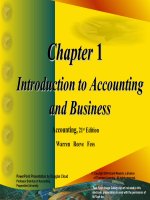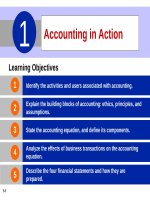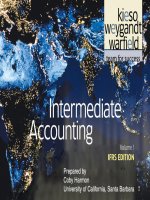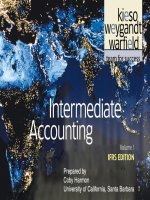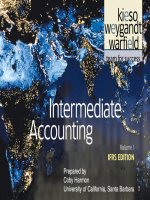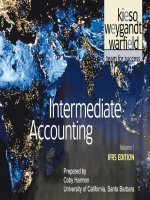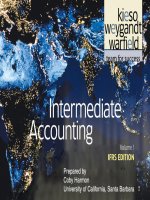Intermediate accounting volum 1 IFRS edition chapter 01
Bạn đang xem bản rút gọn của tài liệu. Xem và tải ngay bản đầy đủ của tài liệu tại đây (1.15 MB, 48 trang )
Slide
1-1
CHAPTER
1
FINANCIAL REPORTING AND
ACCOUNTING STANDARDS
Intermediate Accounting
IFRS Edition
Kieso, Weygandt, and Warfield
Slide
1-2
Learning
Learning Objectives
Objectives
Slide
1-3
1.
Identify the major financial statements and other means of
financial reporting.
2.
Explain how accounting assists in the efficient use of scarce
resources.
3.
Explain the need for high-quality standards.
4.
Identify the objective of financial reporting.
5.
Identify the major policy-setting bodies and their role in the
standard-setting process.
6.
Explain the meaning of IFRS.
7.
Describe the challenges facing financial reporting.
Financial
Financial Reporting
Reporting and
and Accounting
Accounting Standards
Standards
Global Markets
Financial
statements and
financial reporting
Accounting and
capital allocation
High-quality
standards
Objective of
Financial
Reporting
General-purpose
financial statements
Capital providers
Entity perspective
Decision-usefulness
Standard-Setting
Organizations
IOSCO
IASB
Hierarchy of IFRS
Financial
Reporting
Challenges
Political
environment
Expectations gap
Significant financial
reporting issues
Ethics
International
convergence
Slide
1-4
Global
Global Markets
Markets
World markets are becoming increasingly intertwined.
Top 20 Global Companies In Terms Of Sales
Slide
1-5
Global
Global Markets
Markets
Significant number of foreign companies are found on
national exchanges.
Illustration 1-2
International Exchange
Statistics
Slide
1-6
Global
Global Markets
Markets
Financial Statements and Financial Reporting
Characteristics of accounting are:
Slide
1-7
(1)
the identification, measurement, and communication
of financial information about
(2)
economic entities to
(3)
interested parties.
LO 1 Identify the major financial statements and other means of financial reporting.
Global
Global Markets
Markets
Economic Entity
Financial Statements
Additional Information
Financial
Information
Statement of
Financial Position
President’s letter
Accounting?
Income Statement
or Statement of
Comprehensive
Income
Identify
and
Measure
and
Communicate
Statement of Cash
Flows
Statement of
Changes in Equity
Prospectuses
Reports filed with
governmental
agencies
News releases
Forecasts
Environmental
impact statements
Note Disclosures
Slide
1-8
Etc.
LO 1 Identify the major financial statements and other means of financial reporting.
Global
Global Markets
Markets
Accounting and Capital Allocation
Resources are limited. Efficient use of resources often
determines whether a business thrives.
Illustration 1-3
Capital Allocation Process
Slide
1-9
LO 2 Explain how accounting assists in the efficient use of scare resources.
Global
Global Markets
Markets
High Quality Standards
Globalization demands a single set of high-quality
international accounting standards. Some elements:
1. Single set of high-quality accounting standards established by
a single standard-setting body.
2. Consistency in application and interpretation.
3. Common disclosures.
4. Common high-quality auditing standards and practices.
5. Common approach to regulatory review and enforcement.
6. Education and training of market participants.
(Continued)
Slide
1-10
LO 3 Explain the need for high-quality standards.
Global
Global Markets
Markets
High Quality Standards
Globalization demands a single set of high-quality
international accounting standards. Some elements:
7. Common delivery systems (e.g., eXtensible Business
Reporting Language—XBRL).
8. Common approach to corporate governance and legal
frameworks around the world
Slide
1-11
LO 3 Explain the need for high-quality standards.
Slide
1-12
LO 3 Explain the need for high-quality standards.
Objective
Objective of
of Financial
Financial Accounting
Accounting
Objective: Provide financial information about the reporting
entity that is useful to
present and potential equity investors,
lenders, and
other creditors
in making decisions in their capacity as capital providers.
Slide
1-13
LO 4 Identify the objectives of financial reporting.
Objective
Objective of
of Financial
Financial Accounting
Accounting
General-Purpose Financial Statements
Provide financial reporting information to a wide variety
of users.
Provide the most useful information possible at the
least cost.
Capital Providers (Investors)
Investors are the primary user group.
Slide
1-14
LO 4 Identify the objectives of financial reporting.
Objective
Objective of
of Financial
Financial Accounting
Accounting
Entity Perspective
Companies viewed as separate and distinct from their owners.
Decision-Usefulness
Investors are interested in assessing the company’s
1. ability to generate net cash inflows and
2. management’s ability to protect and enhance the
capital providers’ investments.
Slide
1-15
LO 4 Identify the objectives of financial reporting.
Objective
Objective of
of Financial
Financial Accounting
Accounting
Review Question
The objective of financial reporting places most
emphasis on:
a. reporting to capital providers.
b. reporting on stewardship.
c. providing specific guidance related to specific
needs.
d. providing information to individuals who are
experts in the field.
Slide
1-16
LO 4 Identify the objectives of financial reporting.
Objective
Objective of
of Financial
Financial Accounting
Accounting
Review Question
General-purpose financial statements are prepared
primarily for:
a. internal users.
b. external users.
c. auditors.
d. government regulators.
Slide
1-17
LO 4 Identify the objectives of financial reporting.
Standard-Setting
Standard-Setting Organizations
Organizations
Two Major Organizations:
International Accounting Standards Board (IASB)
Issues International Financial Reporting Standards
(IFRS).
Standards used on most foreign exchanges.
Standards used by foreign companies listing on U.S.
securities exchanges.
IFRS used in over 115 countries.
Slide
1-18
LO 5 Identify the major policy-setting bodies and
their role in the standard-setting process.
Standard-Setting
Standard-Setting Organizations
Organizations
Two Major Organizations:
Financial Accounting Standards Board (FASB)
Issues Statements of Financial Accounting
Standards (SFAS).
Required for all U.S.-based companies.
Slide
1-19
LO 5 Identify the major policy-setting bodies and
their role in the standard-setting process.
Standard-Setting
Standard-Setting Organizations
Organizations
International Organization of Securities
Commissions (IOSCO)
Does not set accounting standards.
Dedicated to ensuring that global
markets can operate in an efficient
and effective basis.
/>
Slide
1-20
LO 5 Identify the major policy-setting bodies and
their role in the standard-setting process.
Standard-Setting
Standard-Setting Organizations
Organizations
International Accounting Standards Board (IASB)
Composed of four organizations—
International Accounting Standards
Committee Foundation (IASCF)
International Accounting Standards
Board (IASB)
Standards Advisory Council
International Financial Reporting
Interpretations Committee (IFRIC)
Slide
1-21
LO 5 Identify the major policy-setting bodies and
their role in the standard-setting process.
Standard-Setting
Standard-Setting Organizations
Organizations
Illustration 1-4
International Standard-Setting Structure
Slide
1-22
LO 5 Identify the major policy-setting bodies and
their role in the standard-setting process.
Standard-Setting
Standard-Setting Organizations
Organizations
Review Question
IFRS stands for:
a. International Federation of Reporting Services.
b. Independent Financial Reporting Standards.
c. International Financial Reporting Standards.
d. Integrated Financial Reporting Services.
Slide
1-23
LO 5 Identify the major policy-setting bodies and
their role in the standard-setting process.
Standard-Setting
Standard-Setting Organizations
Organizations
Review Question
The major key players on the international side are
the:
a. IASB and FASB.
b. SEC and FASB.
c. IOSCO and the SEC.
d. IASB and IOSCO.
Slide
1-24
LO 5 Identify the major policy-setting bodies and
their role in the standard-setting process.
Standard-Setting
Standard-Setting Organizations
Organizations
Review Question
Which body from the U.S. side is similar to the IASB?
a. SEC.
b. FASB.
c. FASC.
d. FAF.
Slide
1-25
LO 5 Identify the major policy-setting bodies and
their role in the standard-setting process.


